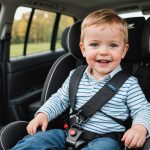Overview of Child Safety Regulations in the UK
The UK has established a comprehensive legal framework for child safety in vehicles, crucial for protecting young passengers. Adhering to these regulations not only safeguards children but also helps avoid legal repercussions for caregivers. These rules dictate the use of appropriate child restraints like car seats and booster cushions, calibrated to a child’s weight and height. Notably, children must use a suitable car seat until they reach the age of 12 or a height of 135 cm, whichever comes first.
Key Agencies
Several agencies play a pivotal role in regulating and enforcing child safety aspects in vehicles. The Department for Transport (DfT) is the primary authority, setting standards and policies related to vehicle safety. In conjunction, local authorities and law enforcement ensure compliance through regular checks and educational initiatives. Moreover, Trading Standards are instrumental in verifying that car seats meet necessary safety standards and are marketed correctly to consumers.
Topic to read : The Ultimate Guide to Choosing the Perfect Polish for Chrome Finishes on Classic British Motorcycles
The importance of adhering to UK child safety vehicle regulations cannot be overstated. Compliance ensures the diminishment of injury risks during accidents, promoting the well-being of young passengers. Following these guidelines signifies a commitment to safety and legal responsibility.
Essential Child Safety Features
When it comes to child safety in UK vehicles, there are several features mandated by law to ensure the protection of young passengers. These features, crucial for minimizing risks during travel, include seat belts, child locks, and ISO-FIX anchor points.
Have you seen this : Ultimate Guide to the Best Paint Protection Films for Safeguarding British Luxury Cars
Seat belts are perhaps the most basic and significant safety feature. They are designed to restrain passengers in their seats during a collision. For children, specially designed seat belts are essential, as they are suited for smaller bodies, reducing the risk of injury.
Child locks, commonly found on rear doors, prevent children from opening doors while the vehicle is in motion. This ensures that curious hands do not accidentally put themselves in danger when the vehicle is operational.
The inclusion of ISO-FIX anchor points in vehicles offers a simple, risk-reducing way of securing child seats without the need for seat belts. This mechanism allows a quick and reliable method of attaching a child safety seat to the vehicle frame.
Recent updates in regulations have emphasized the importance of these features. Stricter guidelines for child restraint systems have been introduced, ensuring they meet stringent safety standards, ultimately enhancing child safety in UK vehicles. Understanding and using these features can significantly contribute to passenger safety.
Verifying Compliance with Child Safety Standards
Safeguarding your child’s travel experience begins with conducting a thorough child safety features compliance verification. This ensures that your vehicle meets the rigorous UK safety standards designed to protect young passengers. But how can you effectively assess this compliance?
The initial step involves familiarising yourself with the UK-specific requirements concerning child safety in vehicles. These standards encompass aspects like the correct installation of car seats, seatbelt integrity, and airbag functionality. Consulting official resources or organisations dedicated to road safety can provide insights into these regulations.
To facilitate this, numerous tools and resources for verifying compliance are at your disposal. Checklists and user-friendly mobile apps can streamline the verification process, offering distinct guidance on meeting these standards. They also serve as ongoing reference points for routine checks and assessments.
Regular checks and maintenance are critical to ensuring that safety features remain functional and effective. Frequent audits help in identifying potential wear and tear or faults that could compromise child safety. By prioritising regular verification, you not only uphold compliance but also fortify the security and protection of your child in every journey they undertake.
Practical Tips for Parents
Children’s safety in vehicles is a top priority, and understanding the best practices is crucial for parents. Proper installation of car seats is one such practice. Ensuring the seat is securely fastened and suitable for your child’s size can significantly reduce risks.
Educating children about vehicle safety is equally important. Teaching them to buckle up before the vehicle starts moving and explaining the dangers of distractions in the car fosters a safety-first mindset from a young age. Emphasise that car journeys require caution and following safety rules.
Routine checks are indispensable for maintaining a safe environment within the vehicle. Regularly inspect seat belts, airbags, and car seats to confirm they are functioning correctly. It’s advisable to schedule periodic reminders for these safety checks to ensure nothing is overlooked.
In addition, reaffirming safety rules with children reinforces their importance. Discussing why these guidelines are essential can help children understand their role in staying safe and foster their active participation in maintaining vehicle safety.
By integrating these practices, parents can make informed decisions and help ensure their children’s safety in vehicles. Safe habits, once established, can reinforce a lifelong commitment to responsible behaviour on the road.
Visual Aids and Resources
In the realm of child safety, numerous resources exist to ensure parents are well-equipped with the necessary knowledge. One of the most effective tools includes visual aids, such as checklists and infographics that can guide parents through essential safety measures. These aids often include diagrams and step-by-step illustrations, making it easier for parents to understand and implement safety practices.
Educational materials range from simple seatbelt checks to more complex information about the appropriate use of child safety seats. For example, an infographic might detail the proper installation of a car seat, highlighting common errors and their corrections. Such visual guides not only educate but reinforce safe practices through clear, understandable visuals.
Other resources for parents include comprehensive websites and organizations dedicated to this critical aspect of child safety. Some notable examples include the American Academy of Pediatrics and the National Highway Traffic Safety Administration, which provide online checklists and visual guides tailored for different age groups and vehicle types. By exploring these resources, parents can make informed decisions, leveraging tools like tutorials and video demonstrations that elevate their understanding and ensure the utmost safety of their children in vehicles.











